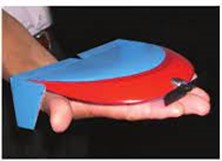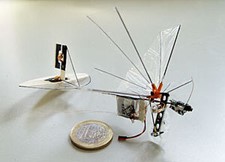
Unmanned Aerial Vehicles or UAVs is a phrase we have heard on multiple fronts. These UAVs are Aircrafts that are piloted remotely by some person who is at a different place. These UAVs of various sizes and shapes can fly continuously for more than 24 hours and some of them can only fly for less than 30 minutes. Some UAVs have wings of several meters long, whereas some have wings of length less than 200 mm. These UAVs, which have wings of length less than 200 mm, are called Micro-Air Vehicles or MAVs.
History
The early UAVs started at the end of the 19th century as nothing more than powered gliders. Later they evolved into remote-controlled aircraft models. One such example of an early UAV was proposed by a French Artillery officer named Rene Lorin, a jet-powered flying bomb controlled via a remote in a crewed aircraft. The development further increased with the incorporation of newer technologies like Automatic stabilization, Autonomous navigation, remote control via satellites, etc. This development of the UAVs leads them to become more efficient.
One direction of development where smaller UAVs are required leads to the development of MAVs. These MAVs come in different shapes and sizes and can be categorized based on the type of mechanism to achieve flight. These are broadly categorized as Fixed-wing MAVs, Rotary wing MAVs and Flapping wing MAVs
Fixed-wing MAVs
Fixed-wing MAVs are nothing but model aircraft of size less than 200 mm, which are controlled remotely. Some of these can be as small as the size of a human palm, as shown in the figure. These MAVs basically will have a wing and a propellor, which will help them to fly. The control of these MAVs is done the same way how we control a typical aircraft.

Rotary wing MAVs
Rotary wing MAVs are tiny helicopters, which are controlled remotely. Like Helicopters, these also don’t have wings on them and they will depend on their rotors to achieve flight. These are the most common MAVs we see in use nowadays. They are used basically from military surveillance to disaster management. There are proposals nowadays to even use them for delivering your orders by companies like Amazon.

Flapping wing MAVs
Flapping wing MAVs are the recent trend in the development of MAVs. These are the most complicated of all the MAVs as they use the same type of mechanism birds use to achieve flight. Birds flap their wings in a particular way to achieve flight and the way they flap their wings varies with the type of bird. Smaller birds have one way of flapping, whereas bigger birds have a different way of flapping their wings. Insects that are capable of flying have different ways of flapping their wings themselves. The MAV, in the picture below, is designed by observing the wing flapping of Dragonfly. A new type of flapping-wing MAVs is designed nowadays, which are the size of a mosquito.

Other types of MAVs use a combination of different kinds of flying mechanisms. These include MAVs where they use rotary-wing mechanism for lift-off and then modify mid-air to become Fixed-wing MAV.
Uses of MAVs
All these different types of MAVs can be used for various applications. These include both Civilian and Military uses. Civilian uses include
- Observing the traffic patterns in busy traffic lanes and changing the traffic signal timings to reduce traffic congestion.
- Surveying of lands from the air to get live data. This surveying of lands can help determine the type of crops that the farmers have laid in what hectarage, allowing the procuring agencies to prepare well in advance for the harvest time.
- Providing disaster relief during times of natural calamities.
- Doorstep delivery of Packages from companies like Amazon.
- Keeping a tab on Endangered species in the wild and many other uses.
Military uses include
- Surveillance of border areas to control cross-border terrorism.
- For attacking the enemies and their facilities.
- Spying on the enemy and many other uses.
Technological Advancements
Nowadays, the number of uses for the MAVs necessitated the increase of the efficiency of the MAVs. Achieving this increase in efficiency was done by improving the Aerodynamics, reducing the size, using multiple numbers simultaneously (swarming), increasing the autonomy, and many other ways. These technological advancements are still in the development phase and yet to come in the real world.
The current research in the aerodynamics of MAVs is done to understand the complex physics behind how these wings achieve flight. These researches include how the shape of the Dragonfly wing, which is very rough, is producing the lift. Conventional wings on a typical full-size aircraft will have very smooth wings. This smoothness will reduce the amount of energy expended to move the plane and achieve flight. But in a Dragonfly, very complex aerodynamics is observed, which leads to better efficiency for the size of the Dragonfly. For MAVs that are of the Dragonfly’s size, it is prudent to use the aerodynamics of the wing of a Dragonfly. So a lot of research is being done to understand the shape of the wings and the flapping motion of such wings.
Another area of research is about Swarming, which is nothing but the movement of MAVs as a synchronized group, requiring research related to data transfer and analysis of that data in real-time. The synchronized movement of multiple MAVs requires the MAVs to interact with each other about their relative position and the effect of each MAV aerodynamics on the other MAVs. Then each of the MAV has to process this data in real-time and adjust accordingly. This requires the vast computational potential to be incorporated into the small space of each MAV.
Also, the small size of the MAVs presents their challenges. Since the space inside the MAV need to incorporate the batteries, electric motor, electronics to control and navigate the MAV. Much of the research is being done to miniaturize these components, as even a small increase in efficiency can substantially increase the MAV capabilities.
New age MAVs
Currently, a good number of MAVs have been designed. ‘AeroVironment Nano Hummingbird’ is one of the MAVs being developed by DARPA in the USA. This is designed based on the aerodynamics of a real Hummingbird. The size of this MAV is slightly larger and heavier than a real Hummingbird but smaller than the largest variety of Hummingbirds.
DelFly is another design, which is based on flapping wing aerodynamics. It is designed by the Micro Air Vehicle Lab of the Delft University of Technology in collaboration with Wageningen University. This flapping-wing design also called an Ornithopter, contains a camera as well.
Even in India, National Aerospace Laboratories and Aeronautical Development Establishment have developed multiple MAV designs, such as NAL / ADE Pushpak, NAL / ADE Golden Hawk, NAL / ADE Black Kite. These airframe designs are pursued as part of the National Program on Micro Air Vehicles(NP-MICAV). The Department of Science and Technology(DST) of India has approved the NP-MICAV program to carry out dedicated research on MAVs. With such a dedicated and focussed program to design, develop and deploy new age MAVs in India, we can say that we are on the right track to use the capabilities provided by the MAVs.
Prof. K S N Abhinav Kumar
Assistant Professor,
Department of Aerospace Engineering
ACED
